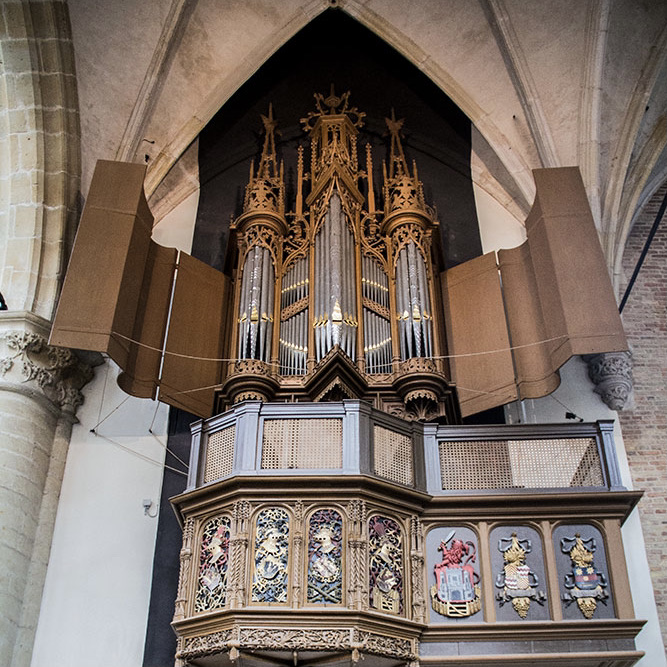VAN COVELENS
Grote Sint Laurenskerk Alkmaar
Organ details
History
- 1545 changes by Claes Willemsz.
- 1551 changes by Allart Claesz.
- 1625 restoration and alteration by Jan Jacobsz. van Lin
- 1630 restoration by Levijn Eekman
- 1651 restoration and alteration by Jacobus van Hagerbeer
- 1703–1704 restoration by Johannes Duytschot
- 1779 restoration by Pieter Müller
- 1894 restoration by L. Ypma & Co
- 1939 restoration by H.W. Flentrop
- 1994–2000 reconstruction by Flentrop Orgelbouw
The Van Covelens organ is more than five centuries old. The exceptional restoration by the Dutch organ builder Flentrop Orgelbouw (1994–2000) has allowed the instrument to regain its former splendour. This unique instrument gives us first-hand contact with the earliest origins of Dutch organ building history.
It was built in 1511 by Jan van Covelens as a single manual instrument with eight stops. Van Covelens divided the pipework of these stops between an upper and lower chest. The lower chest contains the so called ‘Principael’ - what we would now refer to as the ‘plenum’ - consisting of the ‘Doof’, ‘Koppeldoof’, ‘Mixtuur’ and ‘Scharp’. The composition of this ‘Principael’ is a direct descendant of the ‘Blockwerk’, typical of organ building in the middle-ages. A striking element is the principle of doubled ranks; the number of speaking pipes increases towards the treble as a result. On the lowest note, F, the ‘Principael’ consists of seven speaking pipes while on the highest a2 it consists of 17 pipes. In a contract of 1525 Van Covelens characterised the sound of the ‘Principael’ as “liefflick ende scharp van geluyt” (sounding lovely and sharp). The lower chest also contains the Trompet. The three flute stops, ‘Holpyp’, ‘Openfluyt’ and ‘Sufflet’ were placed on the upper chest, the winding for which is transmitted from the lower chest via conduits.
Van Covelens’ pupil Claes Willemsz. enlarged the organ in 1545, adding a Borstwerk with two (or possibly three) stops. This Borstwerk, situated directly behind the keyboard, has the character of an echo division when heard in the church. The present Quintadeen was added by Claes Willemsz.
The Pedaal Trompet was probably added in 1551 by Allart Claesz., son of Claes Willemsz.
Later restorations and alterations were carried out by Jan Jacobsz van Lin (1625), Levijn Eekman (new wind system, 1630), Jacobus van Hagerbeer (1651), Johannes Duytschot (1703-1704), L. Ypma & Co (1894) and H.W. Flentrop (1939).
© Pieter van Dijk (2001)
Multimedia library
Specification
| I. Borstwerk F,G,A-g2,a2 | II. Manuaal F,G,A-g2,a2 | Pedaal F,G,A-c1 | ||||
| Quintadeen 8 Fluit 4 Octaaf 2 Octaaf D I-II 1 | Doof I-II 8 Holpyp 8 Koppeldoof I-II 4 Openfluit 4 Sifflet 1 1/3 Mixtuur II-VI Scharp III-VI Trompet 8 | Trompet 8 | Couplers: BoW-Man (B/D),Ped-Man Tremulant Pitch: a1=427Hz Temperament: meantone Wind pressure: 68mm Wind supply:three wedge bellows | |||


